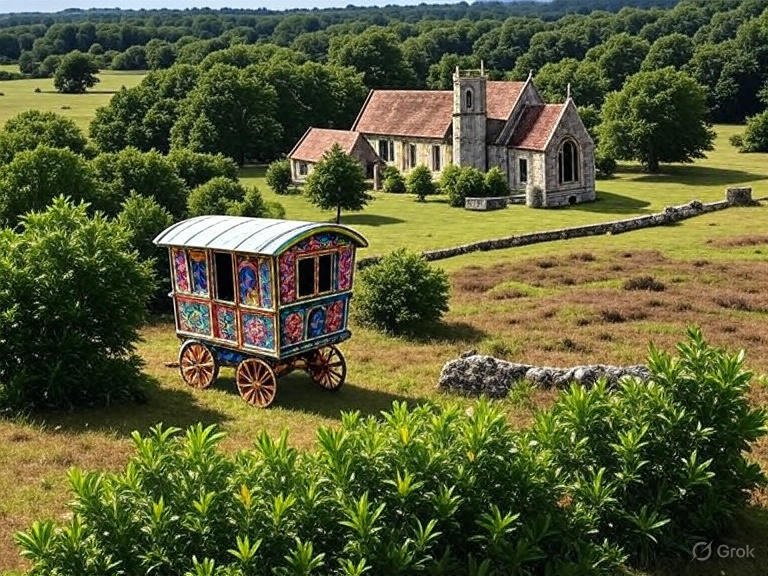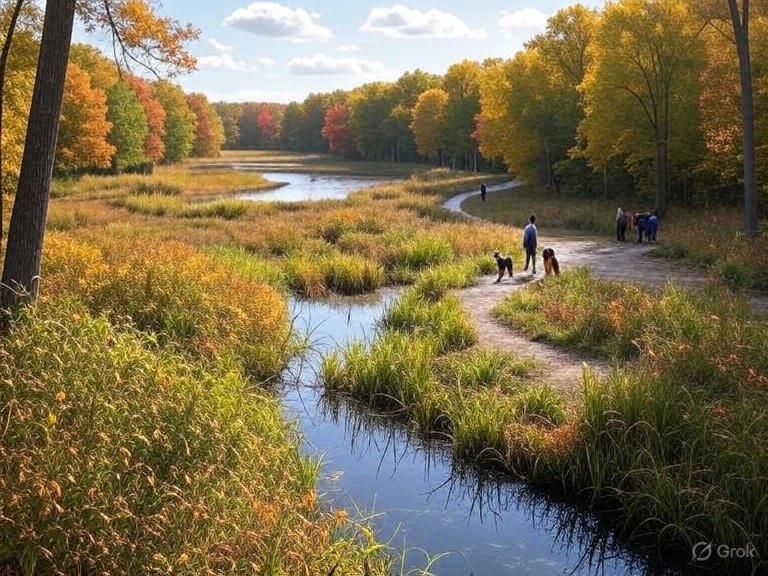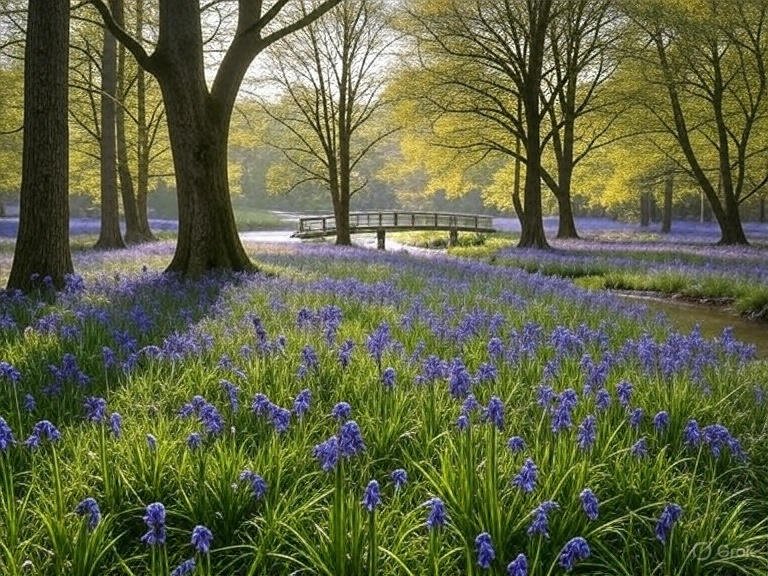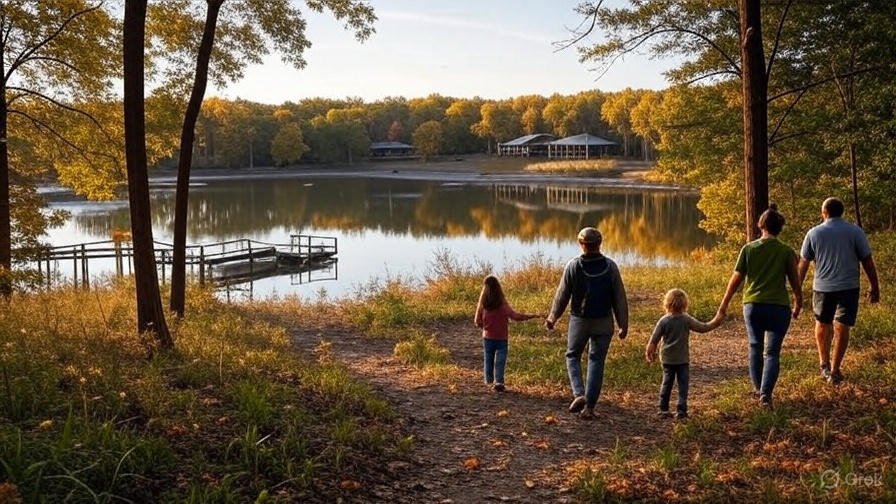Thorney Hill is a special place in the New Forest, England. It hides stories of Romany people, a beautiful church, and secret landscapes. This guide tells you about its history, culture, and nature. It is easy to read and full of facts. Let’s explore Thorney Hill together!
What Makes Thorney Hill Special?
Thorney Hill sits near Bransgore, on the edge of the New Forest. It is a quiet place with a big story. For hundreds of years, Romany people lived here. They were travelers who loved the forest. A lovely church called All Saints’ Church stands here too. It has colorful windows and a rich history. The landscapes around Thorney Hill are hidden gems. You can find green hills, old trees, and secret paths. This article shares these stories in simple words.
Romany Heritage in Thorney Hill
Who Are the Romany People?
Romany people are travelers with a unique culture. They have lived in the New Forest for over 500 years. They moved with the seasons, camping in tents or wagons. They sold flowers, horses, and handmade goods. They worked with local people, cutting wood or picking fruit. Their life was free until the 1900s, when rules changed.
The Thorney Hill Compound
In 1926, the New Forest made rules to stop Romany people from camping freely. They had to live in special places called compounds. Thorney Hill was the biggest compound. Up to 400 people lived there in the 1930s. They stayed in tents or tin shacks with dirt floors. There was only one water tap for everyone. Life was hard, but the Romany people stayed strong. Families like Doe, Sherred, and Hughes lived there. They went to Thorney Hill School nearby.
In 1960, the council built 22 small houses at Thorney Hill. They called it “The Close.” These houses had water and electricity. A warden helped families settle. By 1974, most families moved to new homes in Bransgore or nearby. The Close was taken down to stop others from moving in. Today, you can still see signs of the old houses from the sky in dry summers.
Romany Culture and Artifacts
Romany people made beautiful things. They crafted baskets and pegs. They used special pottery called Imari ware, which came from Japan long ago. Archaeologists found old tools at Thorney Hill, like a hoof clipper and a knife-sharpening wheel. These show how Romany people worked. A group called Romani Community Archaeology digs at Thorney Hill. They work with Romany families to save their history. Their finds will be in a museum at the New Forest Heritage Centre in 2025.
Why Romany History Matters
Romany people faced tough times. Newcomers in the 1900s called them names and wanted them gone. But they were part of the New Forest’s heart. They lived with nature and helped the community. Today, people like me, Douglas Baltes, care about their story. I study nature and love the New Forest. Saving Romany history helps us understand the past. It shows how strong these families were.
All Saints’ Church: A Hidden Gem
A Beautiful Church
All Saints’ Church sits on Burley Road in Thorney Hill. It is called a “Jewel of the New Forest.” Built in 1906, it looks different from other churches. Its walls are red brick, and its windows shine with color. The church feels calm and matches the green forest around it.
The Story of the Church
Lord John and Lady Constance Manners built All Saints’ Church. Lord John won a big horse race in 1881. He used the money to build a house called Avon Tyrrell nearby. Then, he and his wife made the church for the community. It was a gift to Thorney Hill. The church has a tall tower and pretty designs inside. It feels like a warm hug from history.
Inside the Church
The church has special windows with bright colors. They tell stories from the Bible. The wooden roof looks like a ship turned upside down. There are stone carvings too. Some show flowers and animals. The church is open on some Sundays for visits. You can feel the peace when you step inside.
The Church and Romany People
Romany families went to All Saints’ Church. They prayed and shared their lives there. The church has a war memorial outside. It remembers 18 men from Thorney Hill who fought in World War I. Many were Romany. Their names, like Doe and Hughes, are on the stone. The memorial was made by a famous architect, Sir Herbert Baker. It shows how Romany people helped the country.
Hidden Landscapes of Thorney Hill

Exploring the Land
Thorney Hill has secret places to see. The landscapes are wild and quiet. You can walk through green hills called Thorney Hill Holms. Old trees, like oaks and beeches, grow tall. Small streams run through the grass. Some have red water from iron in the ground. These places feel like a step back in time.
As a marine biologist, I know how special nature is. The New Forest is like an ocean on land. Its plants and animals work together. Thorney Hill’s landscapes are home to deer, ponies, and birds. You might see a hawk flying high. The air smells fresh, like the sea.
Thorney Hill Holms
Thorney Hill Holms is a big open area. It has soft hills and patches of heather. Heather is a purple plant that blooms in summer. Long ago, Romany people camped here. You can still find bits of their old homes, like broken pottery. The land feels alive with their stories. Walk slowly to see small flowers or hear birds sing.
Secret Paths and Streams
Paths twist through Thorney Hill’s forests. They are narrow and covered with leaves. Some lead to hidden streams. One stream, called a chalybeate, has red water. People once thought it could heal sick animals. I don’t suggest drinking it! The paths are great for quiet walks. They let you feel close to nature.
Old Airfield Nearby
Near Thorney Hill is an old airfield from World War II. It was called Holmsley. Planes flew from there to help the war. Today, the airfield is gone, but you can see its story at the Friends of the New Forest Airfields Heritage Centre. It’s close to Bransgore. The centre has photos and tools from the war. It shows how Thorney Hill was part of big history.
Visiting Thorney Hill Today
How to Get There
Thorney Hill is easy to find. It’s near Bransgore, off Burley Road. You can drive or take a bus from Bournemouth. The New Forest is in Hampshire, England. It’s about two hours from London by car. The roads are clear, but drive slowly. Ponies and deer might cross!
What to See and Do
- Visit All Saints’ Church: Check the church’s schedule for open days. Look at the colorful windows and war memorial. It’s free to visit.
- Walk Thorney Hill Holms: Bring good shoes. The paths are soft but can be muddy. Look for heather and old Romany artifacts.
- Learn at the Heritage Centre: The New Forest Heritage Centre in Lyndhurst has a Romany exhibit in 2025. It shows photos and tools from Thorney Hill.
- Explore Nearby: Visit the airfield museum or walk to Avon Tyrrell. It’s a big house with gardens.
Tips for Visitors
Bring a map or phone to find paths. Wear comfy clothes for walking. Take water and snacks. The New Forest has no big shops nearby. Don’t touch old things you find—they might be part of history. Respect the land and animals. The New Forest is a special place to keep safe.
Conclusion
Thorney Hill is more than a place. It holds stories of Romany people who lived free. It has a church that shines with beauty. Its landscapes hide secrets of nature and history. As Douglas Baltes, I love places like this. My work with the Australian Marine Conservation Society taught me to care for nature and culture. Thorney Hill shows how people and land connect. This place teaches us to respect the past. Romany families worked hard and loved the forest. The church reminds us of their faith and strength. The landscapes invite us to walk and wonder. Visit Thorney Hill to feel its magic. Share its story with others. Let’s keep it alive for everyone to enjoy.
Disclaimer: The information in this article about Thorney Hill New Forest, its Romany heritage, All Saints’ Church, and hidden landscapes is accurate as of July 2025. Details may change over time. For the latest updates, check with trusted sources like the New Forest Heritage Centre or All Saints’ Church. This article is for informational purposes only and reflects the author’s research and expertise. Always respect the land, culture, and history when visiting Thorney Hill.
Explore More:
Watergate Forest Park Car Park — Your Free Parking Spot for Gateshead’s Nature Escape
Delamere Forest Accommodation: Luxury Woodland Lodges with Hot Tubs & Forest Ranger Experiences

Douglas Baltes is a writer who loves the ocean! He has worked for five years to learn about it. He writes fun stories about the Great Southern Reef in Australia, a big place with giant kelp forests under the water. Douglas has a degree in Marine Biology from the University of Tasmania, so he knows a lot about sea life! He works with nice groups to save the kelp forests. Douglas writes easy and exciting stories about them. He also leads happy projects to help the forests grow again. The Australian Marine Conservation Society loves his work!






